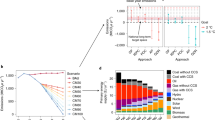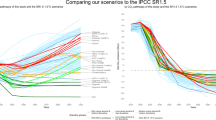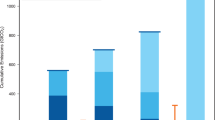Abstract
This paper presents a systematic scenario analysis of how different levels of short-term 2020 emissions would impact the technological and economic feasibility of achieving the 2 °C target in the long term. We find that although a relatively wide range of emissions in 2020—from 41 to 55 billion tons of carbon dioxide equivalent (Gt CO2e yr−1)—may preserve the option of meeting a 2 °C target, the size of this ‘feasibility window’ strongly depends on the prospects of key energy technologies, and in particular on the effectiveness of efficiency measures to limit the growth of energy demand. A shortfall of critical technologies—either for technological or socio-political reasons—would narrow the feasibility window, if not close it entirely. Targeting lower 2020 emissions levels of 41–47 Gt CO2e yr−1 would allow the 2 °C target to be achieved under a wide range of assumptions, and thus help to hedge against the risks of long-term uncertainties.
This is a preview of subscription content, access via your institution
Access options
Subscribe to this journal
Receive 12 print issues and online access
$209.00 per year
only $17.42 per issue
Buy this article
- Purchase on Springer Link
- Instant access to full article PDF
Prices may be subject to local taxes which are calculated during checkout



Similar content being viewed by others
References
Meinshausen, M. et al. Greenhouse-gas emission targets for limiting global warming to 2 °C. Nature 458, 1158–1162 (2009).
Allen, M. R. et al. Warming caused by cumulative carbon emissions towards the trillionth tonne. Nature 458, 1163–1166 (2009).
Zickfeld, K., Eby, M., Matthews, H. D. & Weaver, A. J. Setting cumulative emissions targets to reduce the risk of dangerous climate change. Proc. Natl Acad. Sci. USA 106, 16129–16134 (2009).
Matthews, H. D., Gillett, N. P., Stott, P. A. & Zickfeld, K. The proportionality of global warming to cumulative carbon emissions. Nature 459, 829–832 (2009).
FCCC/CP/2010/7/Add.1 Decision 1/CP.16 (UNFCCC, 2010).
The Emissions Gap Report—Are the Copenhagen Accord Pledges Sufficient to Limit Global Warming to 2 °C or 1.5 °C? (UNEP, 2010).
Rogelj, J. et al. Emission pathways consistent with a 2 °C global temperature limit. Nature Clim. Change 1, 413–418 (2011).
Bowen, A. & Ranger, N. Mitigating Climate Change through Reductions in Greenhouse Gas Emissions: The Science and Economics of Future Paths for Global Annual Emissions (Grantham Research Institute for Climate Change and the Environment, 2009).
Bridging the Emissions Gap - A UNEP Synthesis Report (UNEP, 2011).
Riahi, K., Gruebler, A. & Nakicenovic, N. Scenarios of long-term socio-economic and environmental development under climate stabilization. Technol. For. Soc. Change 74 (special issue), 887–935 (2007).
Rao, S. & Riahi, K. The role of Non-CO2 greenhouse gases in climate change mitigation: Long-term scenarios for the 21st century. Energ. J. 27, 177–200 (2006).
Meinshausen, M., Raper, S. C. B. & Wigley, T. M. L. Emulating coupled atmosphere-ocean and carbon cycle models with a simpler model, MAGICC6—Part 1: Model description and calibration. Atmos. Chem. Phys. 11, 1417–1456 (2011).
Rogelj, J., Meinshausen, M. & Knutti, R. Global warming under old and new scenarios using IPCC climate sensitivity range estimates. Nature Clim. Change 2, 248–253 (2012).
Anderson, K. & Bows, A. Beyond ‘dangerous’ climate change: Emission scenarios for a new world. Phil. Tran. R. Soc. A 369, 20–44 (2011).
Roehrl, R. A. & Riahi, K. Technology dynamics and greenhouse gas emissions mitigation: A cost assessment. Technol. Forecast. Soc. Change 63, 231–261 (2000).
Riahi, K. et al. in Global Energy Assessment—Toward a Sustainable Future Ch. 17 (Cambridge Univ. Press, 2012).
Clarke, L. et al. International climate policy architectures: Overview of the EMF 22 International Scenarios. Energy Econ. 31, S64–S81 (2009).
Nakicenovic, N. & Swart, R. IPCC Special Report on Emissions Scenarios (Cambridge Univ. Press, 2000).
Azar, C. et al. The feasibility of low CO2 concentration targets and the role of bio-energy with carbon capture and storage (BECCS). Climatic Change 100, 195–202 (2010).
IPCC Special Report on Carbon Dioxide Capture and Storage (eds Metz, B., Davidson, O. R., de Coninck, H., Loos, M. & Meyer, L. A.) (IPCC, 2005).
IPCC Special Report on Renewable Energy Sources and Climate Change Mitigation (eds Edenhofer, O. et al.) (Cambridge Univ. Press, 2011).
Ranger, N. et al. Is it possible to limit global warming to no more than 1.5 °C? Climatic Change 111, 973–981 (2012).
Rogelj, J. et al. Copenhagen Accord pledges are paltry. Nature 464, 1126–1128 (2010).
Macintosh, A. Keeping warming within the 2 °C limit after Copenhagen. Energ. Policy 38, 2964–2975 (2010).
IPCC Climate Change 2007: Mitigation (eds Metz, B., Davidson, O. R., Bosch, P. R., Dave, R. & Meyer, L. A.) (Cambridge Univ. Press, 2007).
Den Elzen, M. G. J., van Vuuren, D. P. & van Vliet, J. Postponing emission reductions from 2020 to 2030 increases climate risks and long-term costs. Climatic Change 99, 313–320 (2010).
Smith, S. M. et al. Equivalence of greenhouse-gas emissions for peak temperature limits. Nature Clim. Change 2, 535–538 (2012).
Von Weizsäcker, E., Lovins, A. B. & Lovins, L. H. Factor Four: Doubling Wealth—Halving Resource Use: The New Report to the Club of Rome (Earthscan, 1997).
Van Vliet, J. et al. Copenhagen Accord Pledges imply higher costs for staying below 2 °C warming. Climatic Change 113, 551–561 (2012).
Wise, M. A. et al. Implications of limiting CO2 concentrations for land use and energy. Science 324, 1183–1186 (2009).
World Energy Outlook 2011 (IEA, 2011).
Rogelj, J., Hare, W., Chen, C. & Meinshausen, M. Discrepancies in historical emissions point to a wider 2020 gap between 2 °C benchmarks and aggregated national mitigation pledges. Environ. Res. Lett. 6, 024002 (2011).
Montzka, S. A., Dlugokencky, E. J. & Butler, J. H. Non-CO2 greenhouse gases and climate change. Nature 476, 43–50 (2011).
Meinshausen, M., Wigley, T. M. L. & Raper, S. C. B. Emulating atmosphere-ocean and carbon cycle models with a simpler model, MAGICC6—Part 2: Applications. Atmos. Chem. Phys. 11, 1457–1471 (2011).
O’Neill, B. C., Riahi, K. & Keppo, I. Mitigation implications of midcentury targets that preserve long-term climate policy options. Proc. Natl Acad. Sci. USA 107, 1011–1016 (2009).
Friedlingstein, P. et al. Climate–carbon cycle feedback analysis: Results from the C4MIP model intercomparison. J. Clim. 19, 3337–3353 (2006).
Meehl, G. A., Covey, C., McAvaney, B., Latif, M. & Stouffer, R. J. Overview of the coupled model intercomparison project. Bull. Am. Meteorol. Soc. 86, 89–93 (2005).
Brohan, P., Kennedy, J. J., Harris, I., Tett, S. F. B. & Jones, P. D. Uncertainty estimates in regional and global observed temperature changes: A new data set from 1850. J. Geophys. Res. 111, D12106 (2006).
Domingues, C. M. et al. Improved estimates of upper-ocean warming and multi-decadal sea-level rise. Nature 453, 1090-U1096 (2008).
McCollum, D. L., Krey, V. & Riahi, K. An integrated approach to energy sustainability. Nature Clim. Change 1, 428–429 (2011).
Rafaj, P., Rao, S., Klimont, Z., Kolp, P. & Schöpp, W. Emission of Air Pollutatnt Implied by Global Long-term Energy Scenarios (IIASA, 2010).
Heyes, C., Klimont, Z., Wagner, F. & Amann, M. Extension of the GAINS Model to Include Short-lived Climate Forcers (IIASA, 2011).
IPCC Climate Change 2007: The Physical Science Basis (eds Solomon, S. et al.) (Cambridge Univ. Press, 2007).
McCollum, D. L., Krey, V. & Riahi, K. Beyond Rio: Sustainable energy scenarios for the 21st century. Natural Res. Forum 6, 215–230 (2012).
Prather, M. J. et al. Tracking uncertainties in the causal chain from human activities to climate. Geophys. Res. Lett. 36, L05707 (2009).
Van Vuuren, D. P., van Vliet, J. & Stehfest, E. Future bio-energy potential under various natural constraints. Energ. Policy 37, 4220–4230 (2009).
Acknowledgements
We thank V. Krey, P. Kolp, M. Strubegger and A. Reisinger for their support in developing the model set-up and extracting the results, and A. Grubler and V. Krey for their constructive feedback on the analysis. J.R. was supported by the Swiss National Science Foundation (project 200021-135067) and the IIASA Young Scientists Summer Program 2011. K.R. and D.L.M. greatly acknowledge financial support from the EU-FP7 project AMPERE (FP7-265139).
Author information
Authors and Affiliations
Contributions
All authors were involved in designing the research; J.R. performed the research in close collaboration with D.L.M.; all authors contributed to writing the paper.
Corresponding author
Ethics declarations
Competing interests
The authors declare no competing financial interests.
Supplementary information
Supplementary Information
Supplementary Information (PDF 1104 kb)
Rights and permissions
About this article
Cite this article
Rogelj, J., McCollum, D., O’Neill, B. et al. 2020 emissions levels required to limit warming to below 2 °C. Nature Clim Change 3, 405–412 (2013). https://doi.org/10.1038/nclimate1758
Received:
Accepted:
Published:
Issue Date:
DOI: https://doi.org/10.1038/nclimate1758
This article is cited by
-
Trends and variability in the ocean carbon sink
Nature Reviews Earth & Environment (2023)
-
Adjusting 1.5 degree C climate change mitigation pathways in light of adverse new information
Nature Communications (2023)
-
Mapping the field of bioenergy with carbon capture and storage (BECCS): scientific cooperation and co-citation analyses
Environmental Science and Pollution Research (2023)
-
Microporous metal-organic framework materials for efficient capture and separation of greenhouse gases
Science China Chemistry (2023)
-
Environmental considerations, sustainability opportunities and Iraqi government’s energy policies: a comparative study
Environment, Development and Sustainability (2023)



